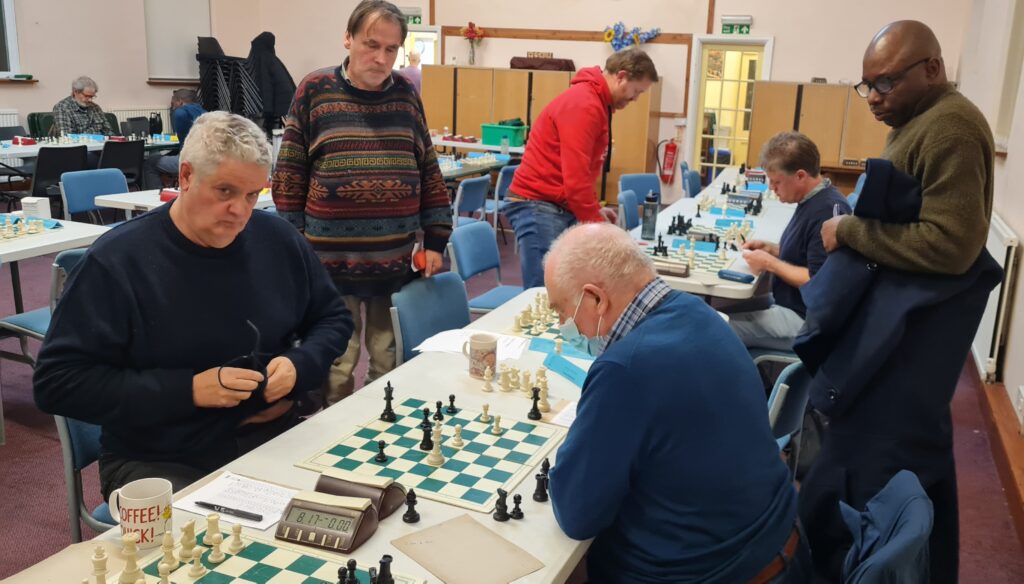Surrey League division 2 match played at Coulsdon on 20 November 2023
At 2-0 down just over two hours into the match, this looked bleak for Kingston 2 against a strong Coulsdon 2 side, with six players of 1850 strength on boards 2 to 7, and a 2000-plus player, Ian Calvert, on board 1. Frankly, with my position against Nick Edwards on board 5 going downhill fast and other games unclear, I feared a thrashing.
John Foley had gone wrong in a tactical melee on board 2 and lost to Paul Jackson. With White on board 6, Nick Grey played an Alapin Sicilian and said afterwards that, after what he considered Black’s inaccurate 2…Nc6, he was dreaming of a sequence he had seen in several games: 1. e4 c5 2. c3 Nc6 3. d4 cxd4 4. cxd4 d5 5. Nc3 dxe4 6. d5 Ne5 7. Qa4+ Bd7 8. Qxe4 Ng6 9. Nb5 Nf6 10. Nd6#.
Very nice, but sadly it remained a dream. Black played the more conservative 5….e6 and Nick’s dreams of a brilliancy were stifled. He nevertheless continued to believe he could exploit what he considered a dodgy move order and went for a big attack against Black’s uncastled king. But he couldn’t quite make it work, and down on both material and time there was no way back once the assault had been neutralised.
So 2-0, but now the fightback began. Alan Scrimgour, with Black on board 3, played expertly to get on top in a tight game. “Playing against a Closed Sicilian,” Alan explained afterwards, “I got some piece activity at the cost of an isolated queen’s pawn. The position was finely balanced until my opponent unwisely exchanged his fianchettoed bishop for a knight, only realising afterwards that it didn’t win a pawn. The subsequent white square weaknesses proved difficult to defend, and while I missed a win I still had a good position. White’s efforts to bolster his kingside white squares left the black ones weak, allowing my queen to enter, winning a piece and the game.”
On board 4, Jon Eckert with White essayed a Grand Prix attack against yet another Sicilian. This position was reached:
Here Black made a key error. He played 10. dxe4, but that hands White a healthy advantage. The best move was Ba6, which is still marginally better for White, but gives Black plenty of counter-chances. As it was, the move played allowed Jon to dominate the centre of the board with his queen, attack the black queen along the d-file and plant a knight on e5, attacking the loose pawn on c6. The bishop can never take the knight or Black becomes horribly vulnerable on the dark squares. Jon went on to win the exchange, and, despite his opponent’s valiant efforts to create complications, eventually the game, with his two rooks harassing the black queen on the seventh rank. An excellent Eckertian effort to make it 2-2.
Peter Andrews was playing Ian Calvert in a high-class match-up on board 1. The two had played many times previously and Peter had not managed to win with Black in four previous encounters. Calvert played the Nimzowitsch-Larsen Attack (1. b3), and they reached this already complex position after 7. Qh4:
“I’d had up to here the last time I had Black against Ian and played Bd7, which led to early exchanges and a draw in 29 moves,” Peter recalled. “Looking at the game afterwards (with digital help I admit – I have no books covering this) I found that exf4 gives a much sharper game, of the sort which a 1. b3 player might be trying to avoid.” This more double-edged line soon led to this position:
The game proceeded: 11. Nbc3 Qf7 12. Bxc6 bxc6? “A serious mistake,” says Peter self-critically, “since Qf2 would give White a slight edge, Black being better up to here. I had planned c5 and then d4, blocking his black square bishop long enough to activate my king’s knight, missing that after 12. Qf2 c5 13. b4 d4 14. Ne4 Black’s game is falling apart. White presumably made the same oversight, because he acted to deter c5. Bxc6 was correct and still slightly better for Black.”
White then made a miscalculation of his own, playing 14. d4 in this position:
“This is a mistake,”says Peter, “after which I kept reasonable control of the game. His bishop diagonal is blocked and I can at last develop my kingside: 14…Bxa4 15. bxa4 c4. There is a nice trick here, but both players missed it: Ba3 is possible because after Bxa3 Qh3+ recovers the piece. Black is still better, but less so than the game.
After White’s 23. h3, Peter felt he was on top and ready to attack:
“White’s pawns on d4 and f4 are weak and Black has more entry points on the kingside than White on the queenside,” he explains. There was still an almighty time scramble, but pieces were exchanged and the position resolved itself into a rook and pawn endgame in which Black was clearly better. A crucial win, giving Kingston a 3-2 lead in the match.
Gregor Smith had good drawing chances on board 7, but blundered in time trouble in another rook and pawn endgame. Forget everything else – just learn to play rook endgames! That left the score at 3-3, with just the two captains left standing – me and veteran Nick Edwards. It felt like a spaghetti western.
In truth, Nick completely outplayed me, torturing my rooks with his knight while I could find no decent squares for my own knights. I felt I was being given a positional masterclass. In the position below I started to worry that White’s Nf5 would lead to a sac followed by mate:
The engine suggests the calm Nf8-g6 to staunch the attack, but instead I became fixated on getting the queens off, even though I knew I would stand worse afterwards. I fear I was opting for a slow death rather than an embarrassingly early exit. So I played 19… Qb4. What follows was worse than I feared: 20. Nb5 Qxd2 21. Rxd2 Re6 22. Nxa7 Rce8 23. Nb5 Rc8 24. a4 g6, producing this position where my pieces are hopelessly uncoordinated and my rooks still under the spell of the knight on b5.
The position above felt lost to me, not least as I was well behind on the clock and almost down to my last five minutes (when players are allowed to stop recording their moves, given that the increment is only 10 seconds). But I kept fighting and repositioned my knights, using one as a (very ugly) defender and the other as a (very speculative) attacker. After my 30th move this was the position:
It is still bad for Black, but marginally less bad than it had been five moves earlier. Nick knew he had a plus, but was a bit slow to exploit it – he needed to infiltrate with his other knight. I managed to get some counterplay and my time trouble seemed to affect my opponent more than me – a not uncommon occurrence, especially when one side has to score (because they still have more than five minutes on the clock) while the other doesn’t. An opponent of mine in a tournament long ago complained loudly about this injustice (after he had lost a drawn position), and I can see his point. Perhaps both players should be allowed to stop scoring – in effect to play blitz – once one of them hits the five-minute line.

As it was, my opponent unexpectedly blundered a piece and I was suddenly – and quite undeservedly – winning. Now I just needed to keep my nerve and hold the endgame, where I had rook and knight against bishop and knight – and an extra pawn to boot. Easy-peasy, except that my endgames are notoriously ropey. Or as Peter Andrews tactfully put it, “We know Stephen’s endgames can go off track.” “For a while I was too nervous to watch,” Peter said later, “so went to the kitchen for a coffee. But I could not control my hand sufficiently to get the powder from the jar into the cup without jerking some of it on to the counter.”
Luckily I was not aware of the powerful emotions being stirred (or in this case not stirred) behind me, and felt relatively calm as I went about exploiting my advantage. No doubt there were cleaner, less gut-wrenching ways to win, but I found a route, boiling it down to a king and pawn endgame in which I had the passer. I had beaten a very good player, though not without an enormous slice of luck, and we had won 4-3 in a crucial match – a victory that gives us a fighting chance of survival in a tough division dominated by other clubs’ first teams. Now I think we all deserve that cup of coffee.
Stephen Moss, Kingston captain in Surrey League division 2

